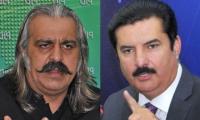ISLAMABAD: Pakistan Muslim League-Nawaz (PMLN), Pakistan Peoples’ Party (PPP) and Pakistan Tehreek-e-Insaf (PTI) are set to maintain their dominance in the Senate despite retirement of several of their senators on March 11.
Keeping in view their strength in the provincial legislatures, following the recent general elections, both PMLN and PPP are likely to pose a challenge to PTI, which, if crosses all legal hurdles, can emerge as the largest party in the Upper House of the Parliament.
The term-wise data of senators explains that PMLN will lose 11 out of its total 16 members, whereas PPP will fall short of 12 out of 21 members, as they complete their six-year term. However, PTI, which had made its way to the Senate for the first time in 2015, will lose only seven out of its 24 members, and hence, will still have 17 remaining in the House even prior to Senate polls. Subject to clearance from the Election Commission of Pakistan (ECP) regarding its intra-party polls, fixed for March 3 and other legal matters, PTI is in a position to possibly outnumber the other two major political parties because of its numerical dominance in Khyber Pakhtunkhwa Assembly and significant presence in Punjab Assembly.
The term of a senator is six years, but half of them retire every three years, and elections are held for new members, as the Senate is the only legislature that remains in existence and is not subject to dissolution.
The full strength of the Senate has been 100, including 23 members each from the four federating units, and four each from erstwhile Fata and Islamabad. The 23 seats allocated to a province comprise 14 general seats, four reserved for women, four for technocrats and one for a minority member. However, now only 96 members will be part of the House, for the representation of the erstwhile tribal areas will end, following the 25th constitutional amendment, which merged them with Khyber Pakhtunkhwa (KP).
Accordingly, the upcoming elections to the Upper House of the Parliament will elect 48 new senators: 11 each from all the four provinces on general and technocrats seats, two from Islamabad and two minority members from Punjab and Sindh as well.
The House presently consists of 97 members, due to the death of PMLN’s Rana Maqbool Ahmed and the resignation of Shaukat Tarin. Likewise, Balochistan Awami Party’s Anwaarul Haq Kakar also resigned after assuming the office of the caretaker prime minister.
While PTI’s 17 members will exhaust their term in 2027, the seven retiring PTI members include Leader of the Opposition in the House Dr Shahzad Waseem. Prominent among those retiring from PPP include Mian Raza Rabbani, Maula Bux Chandio and Quratulain Marri.
Similarly, Leader of the House Muhammad Ishaq Dar and Mushahid Hussain Syed are among PMLN’s legislators bowing out next month. Five members, belonging to Balochistan Awami Party (BAP), are also completing their term and most prominent among them is Senate Chairman Muhammad Sadiq Sanjrani.
Two senators each from the Jamiat Ulema-e-Islam (JUIF) and the National Party (NP) whose term will end on March 11: former law minister Farogh Naseem is the only senator from the Muttahida Qaumi Movement-Pakistan (MQM-P), who will complete his term.
Likewise, Pashtunkhwa Milli Awami Party (PkMAP), PML-Functional and Jamaat-e-Islami (JI) have one senator each and all the three set to retire in March.
All six independent senators in the present House are also set to retire in March and they are Deputy Senate Chairman Mirza Muhammad Afridi, Dilawar Khan, Hidayatullah, Hilalur Rehman, Naseebullah Bazai and Shamim Afridi.
It is quite likely that quite a few of those, who are retiring, may return to the House, after the Senate elections. And, this partly depends on their respective party’s priorities as well as their numerical presence in the respective legislatures.
In the backdrop of their power-sharing deal, it is obvious, PPP will most likely field its candidate for the slot of chairman Senate, who will be supported by PMLN and their other allies.
Elections to fill the seats allocated to each province are held in accordance with the system of proportional representation, by means of the single transferable vote, and members of each provincial assembly elect their respective representatives, whereas members of the National Assembly vote to elect senators from Islamabad.
Chapter VII of the Elections Act, 2017, deals with the Senate elections while Section 107 says,: Notification for election.—(1) The Commission shall, by notification in the official Gazette, call upon the members of the assembly of a province or, as the case may be, the National Assembly to elect such number of members to the Senate from that province or the Islamabad Capital Territory, as the case may be, as is specified in the notification.







